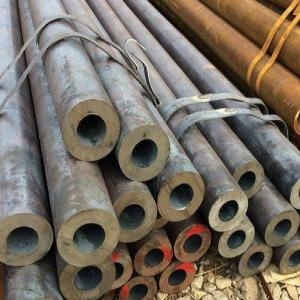Introduction to welding technology of Stainless steel welded pipePosted by BAOWI STEEL MANUFACTURING CO.,LTD on April 9th, 2024  Stainless steel welded pipes are formed by rolling stainless steel plates through several molds on a welded pipe forming machine and then welded. Due to the high strength of stainless steel and its structure of face-centered cubic lattice, it is easy to form work hardening, so when the welded pipe is formed: On the one hand, the mold has to withstand greater friction, making the mold prone to wear;On the other hand, the stainless steel sheet is easy to bond (occupy) with the surface of the mold, causing strain on the welded pipe and the surface of the mold. Therefore, a good stainless steel forming mold must have extremely high wear resistance and anti-adhesion (seizure) properties. Our analysis of imported welded pipe molds shows that the surface treatment of such molds is treated with superhard metal carbide or nitride coating. Compared with traditional fusion welding, laser welding and high-frequency welding have the characteristics of fast welding speed, high energy density, and small heat input. Therefore, the heat-affected zone is narrow, the grain growth is small, the welding deformation is small, and the cold working forming performance is good. It is easy to realize automated welding and single-pass penetration of thick plates. The most important feature is that I-shaped groove butt welding does not require filling materials. Welding technology is mainly used on metal base materials. Commonly used ones include arc welding, argon arc welding, CO2 shielded welding, oxygen-acetylene welding, laser welding, electroslag pressure welding, etc. Non-metallic materials such as plastics can also be welded. There are more than 40 metal welding methods, which are mainly divided into three categories: fusion welding, pressure welding and brazing. Fusion welding is a method in which the workpiece interface is heated to a molten state during the welding process and the welding is completed without applying pressure. During welding, the heat source rapidly heats and melts the interface between the two workpieces to be welded, forming a molten pool. The molten pool moves forward with the heat source, and after cooling, a continuous weld is formed to connect the two workpieces into one body. During the welding process, if the atmosphere is in direct contact with the high-temperature molten pool, the oxygen in the atmosphere will oxidize the metal and various alloying elements. Nitrogen, water vapor, etc. in the atmosphere enter the molten pool, and will also form defects such as pores, slag inclusions, and cracks in the weld during the subsequent cooling process, deteriorating the quality and performance of the weld. To learn more, please visit the website: Like it? Share it!More by this author |


